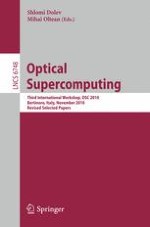This book constitutes the thoroughly refereed post-conference proceedings of the Third International Workshop on Optical SuperComputing, OSC 2010, held in Bertinoro, Italy, in November 2010. The 13 papers presented were carefully reviewed and selected for inclusion in this book. Being an annual forum for research presentations on all facets of optical computing for solving hard computation tasks, OCS addresses the following topics of interest: designs or demonstrations of optical computing devices, algorithmics and complexity issues of optical computing, computation representation by photons and holograms, neural and brain inspired architectures, electro-optic devices for interacting with optical computing devices, practical implementations, analysis of existing devices and case studies, optical photonics and laser switching technologies, optical and photonic memories, optical signal processing subsystems, optical networks for high-performance computing, optical interconnections, quantum optical systems, applications and algorithms for optical devices, Alpha particles, X-rays, and nano-technologies for optical computing.
